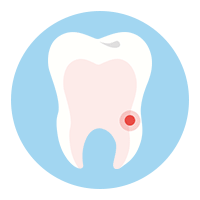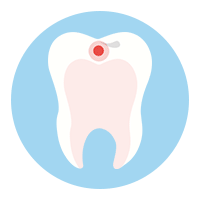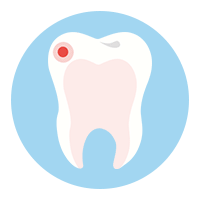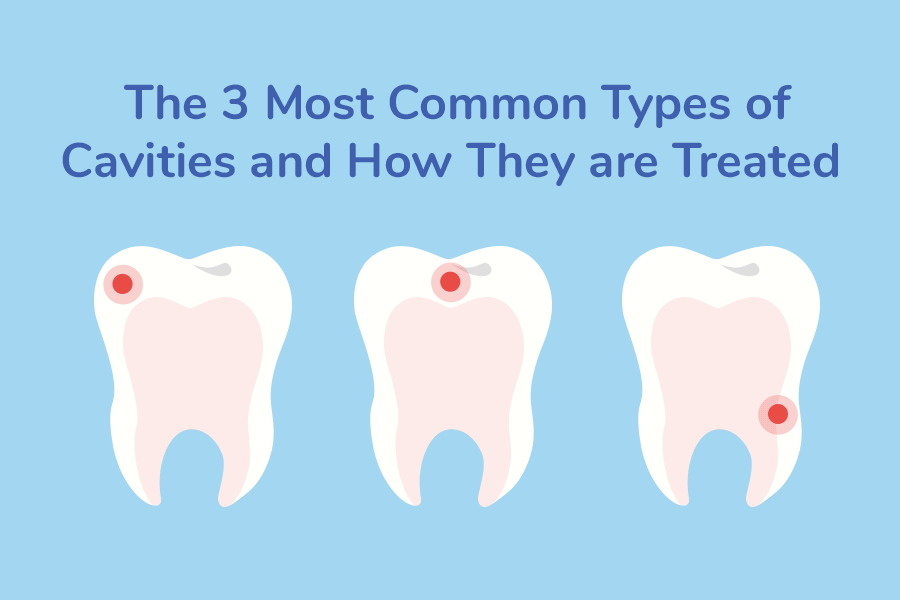When most people think about cavities, they imagine tiny holes in the surface of teeth. While this is a fairly accurate description; cavities can actually affect teeth in different ways. Here are the 3 most common types of cavities, along with the appropriate treatment options for each.
The Major Types of Cavities
- Root cavities – Occurs when cavities form on the root surfaces of teeth.
- Pit and fissure cavities – Areas of decay in the narrow grooves on the biting surfaces of molars.
- Smooth-surface cavities – Slow-growing areas of decay on the flat, smooth surfaces of teeth.
1. Root Cavities

Occurring on the surface of a tooth’s roots, root cavities are more common in older adults, particularly seniors, who more likely to have gum disorders including receding gums. When gums recede, the tissue around the tooth is much lower on the tooth and the root surfaces become exposed which leaves them more susceptible to erosive acids from one’s diet, bacteria, and decay.
Root Cavity Treatment
To treat root cavities, dentists start by removing any tooth decay and then fill the cavity with a filling. If decay has spread to the pulp, root canal therapy is usually needed. Since this portion of the tooth does not have as much protective enamel, tooth decay can spread relatively quickly. This is why it’s very important to treat root cavities as soon as possible. If a root canal is required or the cavity is large, a crown may be recommended by your doctor as well.
2. Pit and Fissure Cavities

Commonly found on the rear molars, these types of cavities occur on the chewing surfaces of teeth. Since it’s easy for plaque and food to get stuck in the crevices and grooves on the tops of teeth, pit and fissure cavities are quite common, especially for people who don’t brush as often as they should. In some cases, sealants can be used to help protect teeth in children and adults who are at a higher risk of developing pit and fissure cavities.
Pit and Fissure Cavity Treatment
If they are found early, pit and fissure cavities can be treated with sealants or some types of fluoride. Once the cavity becomes deeper, however, a dentist will need to remove decay and repair the tooth with fillings or possibly root canals and crowns.
Fillings typically work well for smaller cavities; however, large pit and fissure cavities often require root canals or crowns because the tooth decay is very deep or the remaining tooth structure is too weak.
3. Smooth-Surface Cavities

Commonly occurring on the teeth found on the sides of the mouth, smooth-surface cavities affect the flat exterior surface of teeth. They are the slowest of the cavities to develop and also the least common. Although they aren’t as common, these types of cavities can be a problem for people who don’t practice good dental hygiene.
Smooth-Surface Cavity Treatment
Since they are slow-growing, smooth-surface cavities are more easily treatable. Many times, they will resolve with the help of fluoride treatments, such as gels, toothpaste, varnish or fluoride-enriched water. It generally takes a lot of time for a cavity to make its way through smooth-surface enamel. When it does, however, a filling will be necessary.
Sometimes, people can develop interproximal cavities which affect the smooth surface between teeth. Dentists usually use x-rays to detect cavities between teeth. If one is found, fluoride treatments often help, unless the cavity entered the tooth’s dentin, in which case a filling is necessary.
Quick Fact: Did you know, 91% of all Americans have some
type of cavity in their teeth?
How Do Dentists Treat Cavities?
There are a few ways dentists can treat cavities, depending on the tooth and severity of the decay. These include:
1. Sealants
Dental sealants are thin, plastic coatings which dentists paint on the chewing surfaces of a patient’s teeth ]to prevent or slow tooth decay. The sealant bonds into the grooves and depressions of the teeth, creating a protective shield over tooth enamel.
2. Fillings
After removing decayed portions of a tooth, dentists can fill the cavity to seal the hole and restore proper function. Teeth can be filled with porcelain, gold, silver, composite resin or amalgam, which consists of mercury mixed with copper, silver, zinc and tin.
3. Root Canals
When cavities lead to inflammation or infections in the tooth pulp, dentists can perform root canal therapy, which eliminates bacteria from the root canal, prevents reinfection and saves the natural tooth. During the process, the infected or inflamed pulp is removed and the inside of the tooth is cleaned and disinfected, before being filled and sealed.
4. Crowns
A crown is a cap or cover placed over a tooth. The crown can restore a patient’s tooth to its normal size, shape and function. Crowns are often used to cover significant tooth damage caused by decay, trauma or root canal therapy. Crowns can be made from a variety of materials, including various metals, porcelain-fused-to-metal, all-resin, all-porcelain, all-ceramic and pressed ceramic. Talk to your dentist to learn about appropriate options for your specific needs.
Catching Cavities Early
According to the Centers for Disease Control and Prevention, 91 percent of all Americans have some type of cavity in their teeth, while another 27 percent have untreated tooth decay.
With prompt treatment, most every type of cavity is treatable without much trouble. When treatment is delayed, however, expensive and lengthy treatments usually become necessary. There is also a risk of developing pain and infection. This is why it’s so important to maintain regular dental checkups to help catch unknown issues before they evolve into serious and expensive dental problems.


 Previous Article
Previous Article

